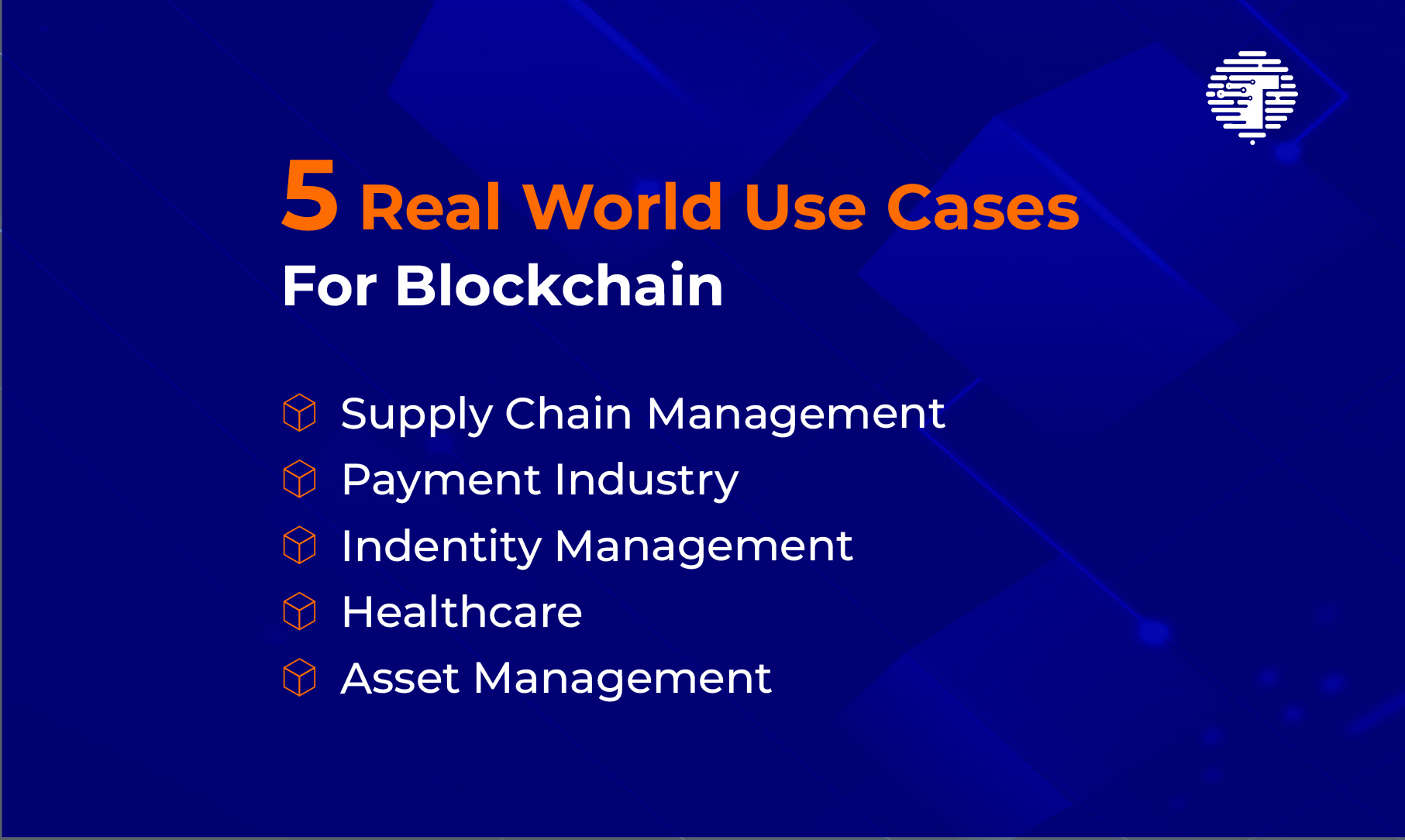With the rise of Bitcoin and other cryptocurrencies, blockchain technology has gained a lot of attention in recent years. But what is blockchain, and what are its potential uses? This content will talk about blockchain use cases you in real-world applications.
What is Blockchain?
Blockchain is a distributed database that allows for secure, transparent, and tamper-proof record-keeping. This database is decentralised, meaning it is stored on a network of computers, known as “nodes”.
There are a growing number of people and businesses using blockchain technology for a variety of purposes. As blockchain becomes more widely accepted, businesses must consider how they can use blockchain to their advantage. Here are 5 Blockchain use cases.
How can Blockchain be used in Supply Chain?

What is Supply Chain Management?
Supply chain management (SCM) is the process of planning, implementing, and controlling the operations of the supply chain with the aim of ensuring that the correct quantity and type of products or services are delivered to the customer at the right time and place.
Challenges faced in Supply Chain Management
There are a number of challenges faced by businesses in the supply chain today, including:
- Minimal asset traceability
One of the biggest challenges in SCM is traceability. It can be difficult to track the movement of goods and materials throughout the supply chain. This is because the supply chain is often complex, with goods moving through many different intermediaries before reaching the end customer. Though industries have made progress in recent years in terms of tracking assets, there is still room for improvement.
- Lack of transparency
Transparency is another key issue in SCM. Because the supply chain is often complex and globalised, it can be difficult for businesses to have visibility into all aspects of their supply chain. This lack of transparency can lead to inefficiencies and errors. It can also make it difficult to ensure that goods are sourced from ethical and sustainable suppliers.
- Counterfeit goods
Counterfeiting is a major problem in many industries, and the supply chain is no exception. Because it can be difficult to track the movement of goods throughout the supply chain, businesses may unwittingly end up selling counterfeit products. This can damage the reputation of the business and lead to legal problems.
- Lack of standardisation
With so many different players involved in the supply chain, it can be difficult to establish and maintain standards. This can lead to errors, inefficiencies, and waste.
- Inefficient cross-border payments
Cross-border payments are another area where the supply chain can be inefficient. Because of the different currencies and payment systems involved, it can be difficult and expensive to make cross-border payments. This can delay and disrupt the supply chain.
How does Blockchain help?
Blockchain has the potential to address many of the challenges faced by businesses in the supply chain. Specifically, blockchain can help to:
- Increase transparency
One of the biggest benefits of blockchain is that it can help to increase transparency throughout the supply chain. With blockchain, businesses can track the movement of goods and materials throughout the supply chain. This tracking can help to ensure that goods are sourced from ethical and sustainable suppliers. It can also help businesses to identify errors and inefficiencies in the supply chain.
- Improve traceability
Another benefit of blockchain is that it can help to improve traceability. By tracking the movement of goods and materials on the blockchain, businesses can more easily identify the source of products and track them throughout the supply chain. This can help to reduce counterfeiting and ensure the quality of products
- Reduce costs
Blockchain can also help businesses to reduce costs. By automating processes and removing intermediaries, blockchain can help businesses to streamline their operations. This can lead to cost savings.
- Quicker Processing
In addition, blockchain can help to speed up the processing of transactions. By using smart contracts, businesses can automate the execution of transactions. This can help to reduce delays and disruptions in the supply chain.
- Increase security
Finally, blockchain can help to increase security throughout the supply chain. By tracking the movement of goods and materials on the blockchain, businesses can have a complete and tamper-proof record of their supply chain. This can help to prevent fraud and counterfeiting.
Blockchain Use Cases in Supply Chain Management
- IBM & Maersk
IBM and Maersk have partnered to use blockchain to create a new digital supply chain platform. The platform will use blockchain to track the movement of goods and assets through the supply chain. This will help to improve the efficiency of the supply chain and reduce the time and cost of shipping goods.
- Walmart
Walmart is piloting a blockchain-based system to track the movement of pork through the supply chain. The system will use blockchain to track the movement of pork from farms to stores. This will help to improve the transparency of the supply chain and ensure that the pork is safe to eat.
How Blockchain can be Used in Payments?
Nowadays, blockchain is being successfully used in various payment systems. Let us see how it helps to make the payments more efficient.

What are the Inefficiencies in the Current Payment System?
The current payment system is inefficient in many ways. First, it is slow. It can take days or even weeks for a payment to be processed. Second, it is expensive. Banks and other financial institutions charge fees for processing payments. Third, it is not very secure. When a payment is made, the payer and payee need to trust that the payment will be processed correctly and that the funds will not be lost or stolen.
How does Blockchain Help?
- Reduced Costs
One of the biggest benefits of using blockchain for payments is that it can help to reduce costs. Because blockchain is a decentralised platform, there is no need for banks or other financial institutions to be involved in processing payments. This can help to reduce the fees that are charged for processing payments.
- Increased Efficiency and Speed
Because blockchain is a digital platform, payments can be processed more quickly than traditional payments. This can help to reduce the time that it takes for a payment to be processed.
- Enhanced Security and Transparency
When a payment is made on the blockchain, it is recorded on the blockchain ledger. This ledger is public, which means that anyone can see the payment that has been made. This can help to reduce the risk of fraud, as it is more difficult to commit fraud on the blockchain. In addition, the use of blockchain can help to increase transparency, as all payments that are made on the blockchain are visible to everyone.
Blockchain Use Cases in Payments
- Circle
Circle is a financial services company that uses blockchain to process payments. Circle was founded in 2013 and is headquartered in Boston, Massachusetts. In 2015, Circle launched Circle Pay, a service that allows bitcoin customers to send money to anyone anywhere in the world no matter what Bitcoin wallet the recipient uses (other cryptocurrencies are not supported on Circle Pay).
- BitPay
BitPay is a payment processing company that uses blockchain to process payments. BitPay was founded in 2011 and is headquartered in Atlanta, Georgia. BitPay allows businesses to accept payments in Bitcoin and other cryptocurrencies. BitPay launched the BitPay Card, a prepaid debit card that allows users to spend Bitcoin and other cryptocurrencies.
How Blockchain can be Used in Identity Management?
Identity management is the process of managing digital identities. Blockchain can be used to store and manage digital identities in a secure and decentralized way.

Problems with Traditional Identity Management
Traditional identity management has several problems. First, it is insecure. Traditional identity management systems are often centralized, which means that they are vulnerable to hacking. Second, it is privacy-invasive. Traditional identity management systems often collect and store a lot of personal data, which can be used to track and spy on people. Third, it is centrally controlled. This means that a single entity, such as a government or corporation, can control who has access to an individual’s identity.
How does Blockchain Help?
- Improved Security
One of the biggest benefits of using blockchain for identity management is that it can help to improve security. Because blockchain is a decentralised platform, it is more difficult for hackers to access an individual’s identity.
- Improved Privacy
Blockchain is a decentralised platform, individuals have more control over their own data. They can choose to share only the data that they want to share, and they can revoke access to their data at any time. In addition, the use of blockchain can help to reduce the amount of personal data that is collected and stored, as only the data that is needed to verify an individual’s identity needs to be stored on the blockchain.
- Decentralised Control
Because blockchain is a decentralised platform, it is not controlled by any single entity. This means that individuals have more control over their own data. They can choose to share only the data that they want to share, and they can revoke access to their data at any time.
Blockchain Use Cases in Identity Management
- Sovrin
Sovrin is powered by the Sovrin Token, which is used to access the Sovrin Network. The Sovrin Foundation is a nonprofit organization that is responsible for the governance of the Sovrin Network.
- uPort
uPort is powered by the Ethereum blockchain, and it uses smart contracts to manage identity data. uPort is developed by ConsenSys, a blockchain software development company.
How Blockchain can be Used in Health Tech to Collect Patient Information?
Health tech is an industry that uses technology to improve the delivery of healthcare. Blockchain can be used in health tech to collect and manage patient data.

Problems with Traditional Patient Information Management
Traditional patient information management has several problems. First, it is insecure. Patient data is often stored in centralised databases, which makes it easy for hackers to access. Second, it is inefficient. Patient data is often siloed, which makes it difficult to share between different healthcare providers. Third, it is inaccurate. Patient data is often manually entered, which can lead to errors.
How does Blockchain Help?
- Improved Security
One of the biggest benefits of using blockchain for patient data management is that it can help to improve security. When patient data is stored on the blockchain, it is encrypted and distributed across a network of computers. This makes it more difficult for hackers to access. In addition, the use of blockchain can help to reduce the risk of data breaches, as it is more difficult to hack a blockchain than a centralized database.
- Improved Privacy
When patient data is stored on the blockchain, it is encrypted and distributed across a network of computers. This makes it more difficult for unauthorised parties to access. In addition, the use of blockchain can help to reduce the risk of data leaks.
- Improved Data Management
When patient data is stored on the blockchain, it is easier to track and manage. This can help to reduce errors and improve the accuracy of patient data. In addition, the use of blockchain can help to reduce the costs of data management, as it is more efficient than traditional methods.
Blockchain Use Cases in Health Tech
- Gem
Gem Health is a blockchain network that aims to improve patient care and operational efficiency by creating a healthcare ecosystem connected to a universal data infrastructure. The company intends to leverage blockchain technology to create a system that is more efficient and patient-centric. By doing so, they hope to improve the overall quality of healthcare for everyone involved.
- Patientory
Patientory is a health tech company that uses blockchain to collect and manage patient data. Patientory was founded in 2015 and is headquartered in Atlanta, Georgia. Patientory allows healthcare providers to collect and share patient data.
How can Blockchain be used in Asset Management?
Asset management is the process of managing assets, such as property, stocks, and bonds. Blockchain can be used to store and manage assets in a secure and decentralised way.

Problems with Traditional Asset Management
Traditional asset management has several problems. First, it is opaque. Traditional asset management systems are often centralised, which means that it is difficult to know where assets are located and who owns them. Second, it is illiquid. Traditional asset management systems often require assets to be held for long periods of time, which can make it difficult to sell them. Third, it is expensive. Traditional asset management systems often charge high fees for managing assets.
How does Blockchain Help?
- Increased Transparency
One of the biggest benefits of using blockchain for asset management is that it can help to increase transparency. With blockchain, all assets are stored on a public ledger. This ledger is visible to everyone, which means that it is easy to track assets and see who owns them.
- Increased Liquidity
. With blockchain, assets can be traded on a decentralised exchange. This exchange is open 24/7, which means that assets can be bought and sold at any time.
- Reduced Costs
With blockchain, there is no need for middlemen, such as brokers or banks. This can help to reduce the fees that are charged for managing assets.
Blockchain Use Cases in Asset Management
- Republic
Republic allows businesses and individuals to invest in startups and other companies. Republic uses blockchain to store and manage investments.
- tZERO
tZERO was founded in 2014 and is headquartered in New York, NY. tZERO allows businesses and individuals to trade digital assets.
Conclusion
In this article, we have seen blockchain use cases in various industries to improve the efficiency of supply chain management, payments, and identity management. We have also seen how blockchain can be used in health tech to collect patient information. While blockchain has the potential to revolutionise many industries, it is still in its early stages of development. It will be interesting to see other blockchain use cases and how blockchain develops in the future.
If you’re looking to hire developers who are experts in blockchain and cryptocurrency, then look no further than Trienpont International. We have a team of experienced developers who can help you with all your needs. Contact us today to get started.





